Don't miss the Alcázar, the Cathedral and the Giralda of Seville!
Visit the magical corners in a spectacular tour with the best guides in the city
Official guide promotion:
(Final price INCLUDING TICKETS)

Visit the magical corners in a spectacular tour with the best guides in the city
Official guide promotion:
(Final price INCLUDING TICKETS)



Official guide
in English

Priority access
skip the line

Best price
guaranteed
Cancellation and
100% refund

The Choir is a fundamental place in the spatial and functional conception of a Cathedral and its origin responds to a tradition linked to the Paleo-Christian basilicas, specifically in the “schola cantorum”. It is usual for the Choir to face the High Altar so that the liturgy can be followed. To this we must add that the cathedral clergy has altar and choir services as fundamental obligations, therefore, the Choir is an essential part, to the point that if there is no Choir there is no Cathedral.
The Choir is accessed through a Renaissance grille from the first half of the 16th century, completed by Francisco de Salamanca. The seats, made of different types of wood and where several authors took part, are from the beginning of the 16th century and have a magnificent sculptural and iconographic program. It should be noted that the 117 seat backs have completely different decorations, made with inlays based on Mudejar lacework. This type of Mudejar adornment in the Choir is only found in the Cathedral of Puebla in Mexico, where the influence of the Cathedral of Seville in New Spain is again evident.
In the center, a large Renaissance lectern, carved in wood, which was used to place the huge liturgical chant books. Dating from the second half of the 16th century, it was made, among others, by Juan Bautista Vázquez “the Old”, who also masterfully carved the Virgin with Child, who presides over the lectern.

In the wall that closes the High Altar, opposite the Royal Chapel, is the trasaltar. It has a composition of 59 statues of kings, bishops and saints, which on corbels and under canopies, make up a sculptural altarpiece of great beauty. These works were made in the 16th century by various authors and cover Gothic, Renaissance and Mannerist styles.
At that time there was a devotion in Seville around pregnant women who asked La Virgen del Reposo to have a good birth. This devotion was of such faith that in the middle of the 16th century the Sevillian nobility ordered the construction of a niche for the Virgen del Reposo to preside over the Back of Altar. Attributed to Miguel Perrín, and due to this devotion, it was known by Sevillians as “Señora del Bienpariese”.
Also noteworthy is the chapel located at the foot of the wall, which serves as a burial place, and which is dedicated to Our Lady of the Soterraño.
In the “Constitution on the Sacred Liturgy”, during the Second Vatican Council, it is ruled that “the pipe organ be held in great esteem, … whose sound can bring remarkable splendor to ecclesiastical ceremonies and powerfully lift souls towards God and to heavenly realities”.
The organ of the Cathedral of Seville is made up of two instruments located in two pieces of furniture (18th century) and that sound from a single console, made up of four keyboards and one pedalboard (from 1901-1903). The left organ was destroyed in 1888 by an earthquake and due to this fact the organ builder Aquilino Amezua rebuilt it. And a novel electrical connection was made in 1973. The sculptures of Duque Cornejo stand out, in the eighteenth-century furniture of Luis de Vilches.
At the end of the 20th century, Gerhard Grenzing was entrusted with a restoration in several phases, sponsored by the Real Maestranza de Caballería de Sevilla. Listening to the organ of the Cathedral with the acoustics provided by the temple, under the sky of vaults and domes, observing the magnificence of the Gothic pillars and the grandeur of the architectural construction is a sensory experience that moves all visitors.

Surrounding the Choir on the outside is the Retrochoir and the Alabaster Chapels, so named because they are built with this material and which support the organs, highlighting the architectural importance of the Choir within the Cathedral of Seville. The Retrochoir, from the 17th century, was made by Miguel de Zumárraga, the chapels were finished by Diego de Riaño in the middle of the 16th century and there are four of them. If we look at the Choir, to the right side are the Chapel of Saint Gregory and the Virgin of the Star, and to the left the Chapel of the Immaculate and the Incarnation.
Due to the amount of historical-artistic details of these spaces, it is advisable to visit with our guides who will give complete information on all the details.


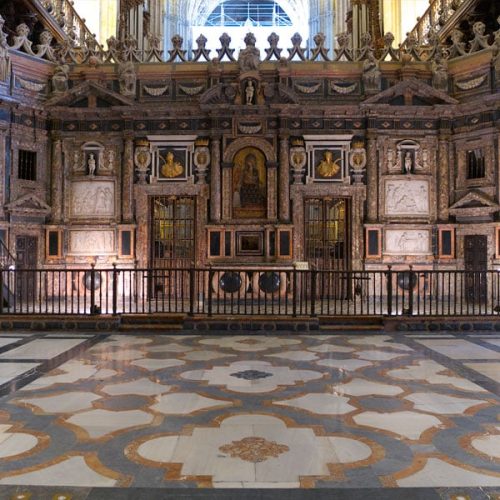
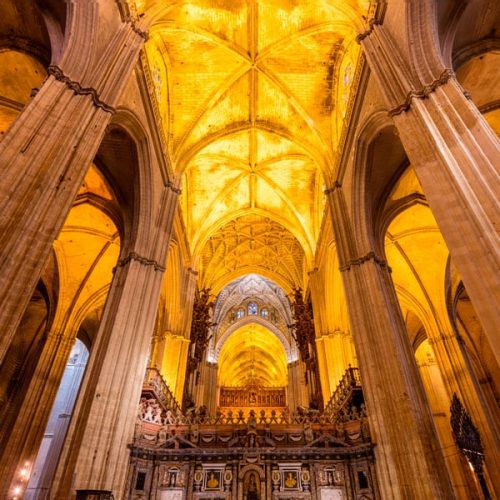
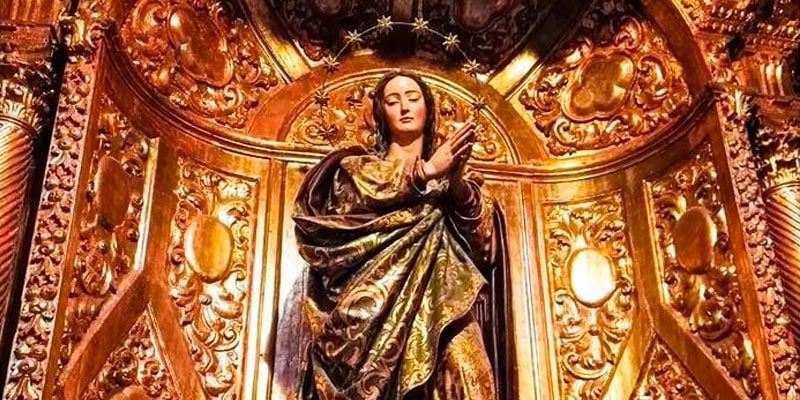
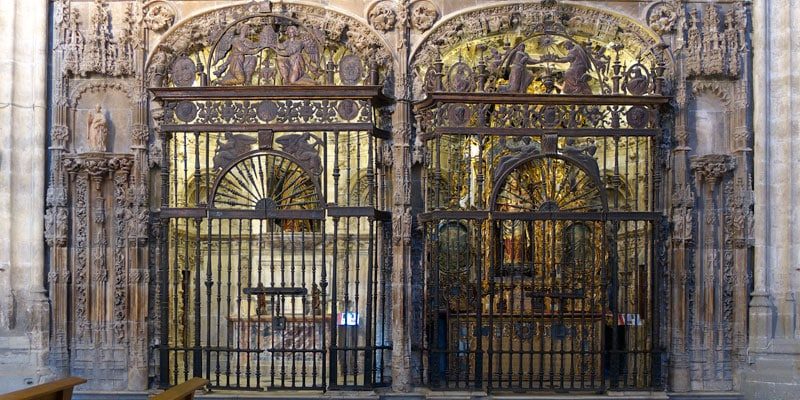
The chapels of the Cathedral of Seville house countless treasures, anecdotes and stories that our guides explain in an entertaining and effective way. We expose here a small structure of the chapels, with some essential data, that visitors will be able to see in our tours of the chapels. From left to right, facing the east wall they meet.
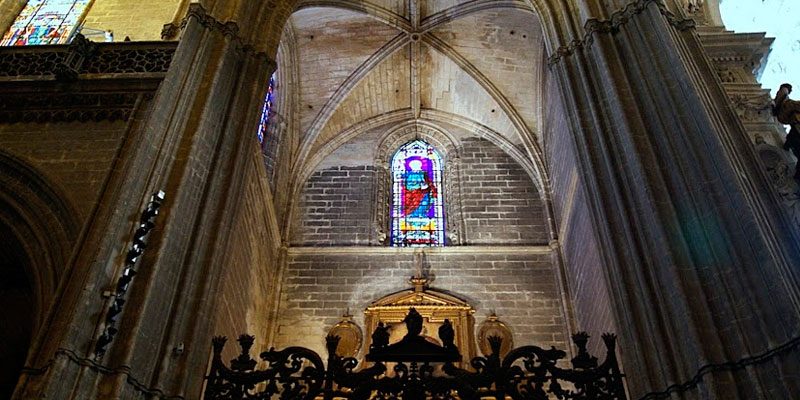
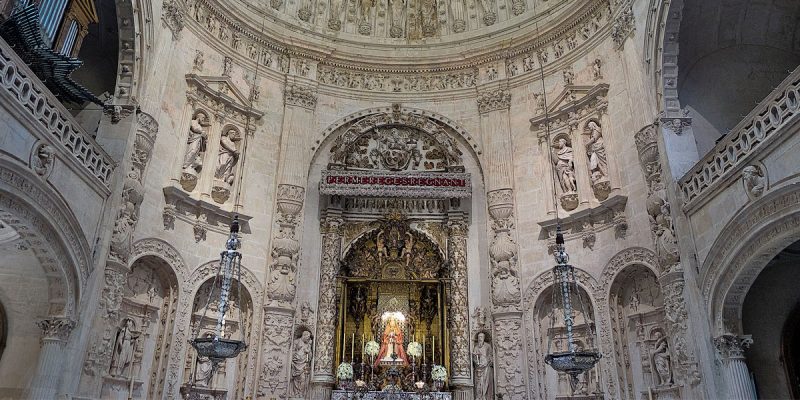
It is Renaissance in style and was made by Hernán Ruiz II in the second half of the 16th century. It functions as the head of the Cathedral and has a hemispherical dome that covers a square space that ends in a semicircular apse flanked by two chapels. Guarding the 17th century altarpiece is the Gothic sculpture of the Virgen de los Reyes, patron saint of the archdiocese and the city of Seville.
In a magnificent baroque silver urn, work of Juan Laureano de Pina, lies King San Fernando, together with several royal tombs, among which that of Pedro I of Castile stands out. Also noteworthy is the altar of the Virgen de las Batallas, an ivory carving from the 13th century.
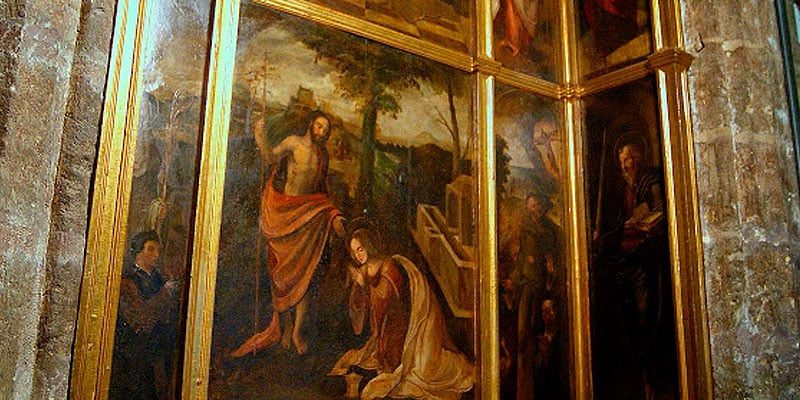
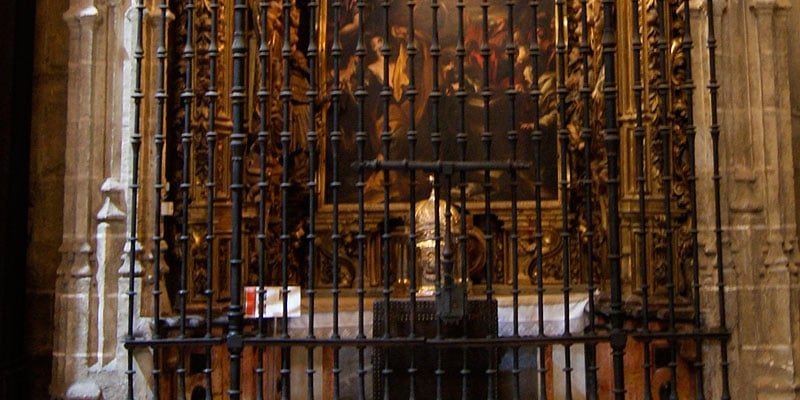
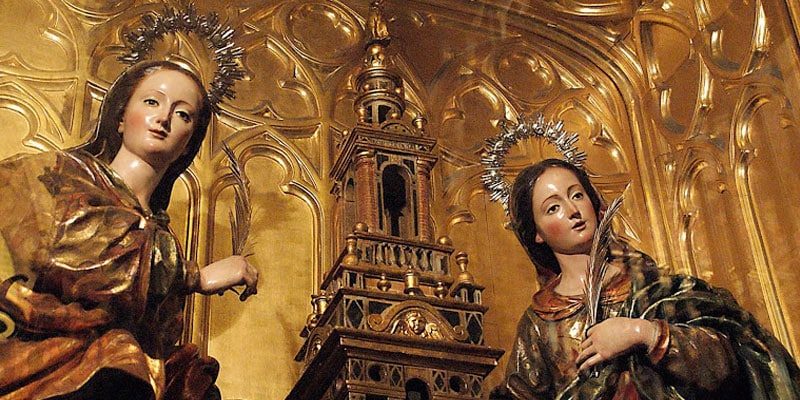
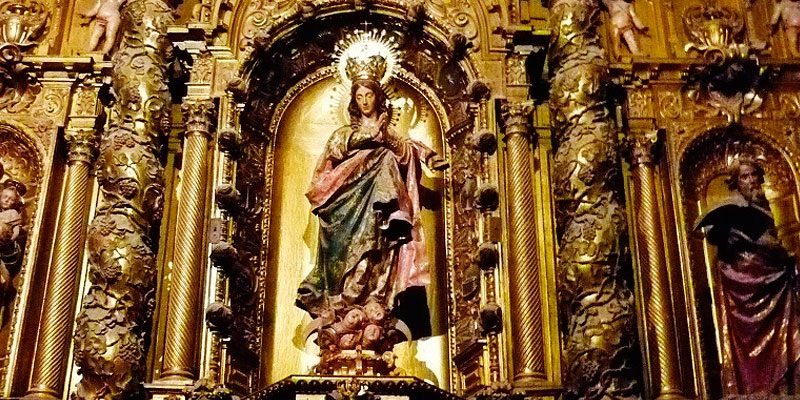
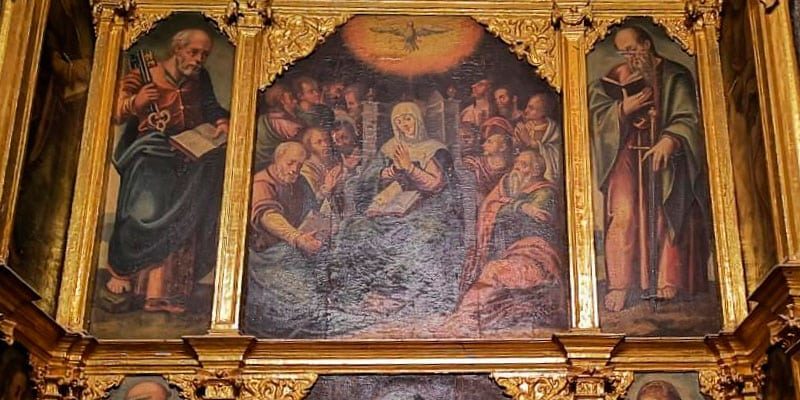
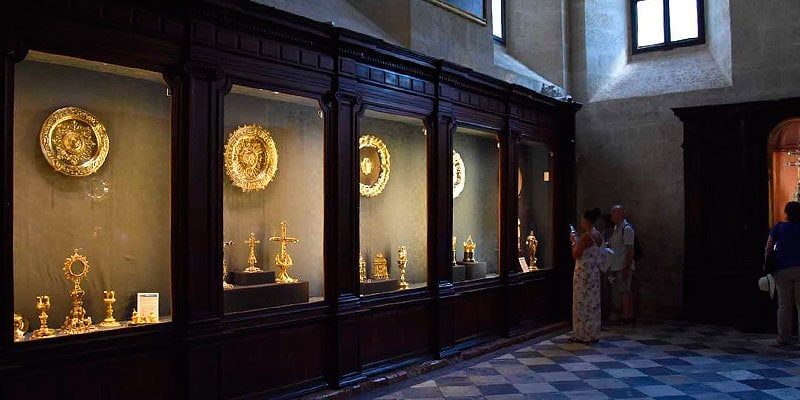
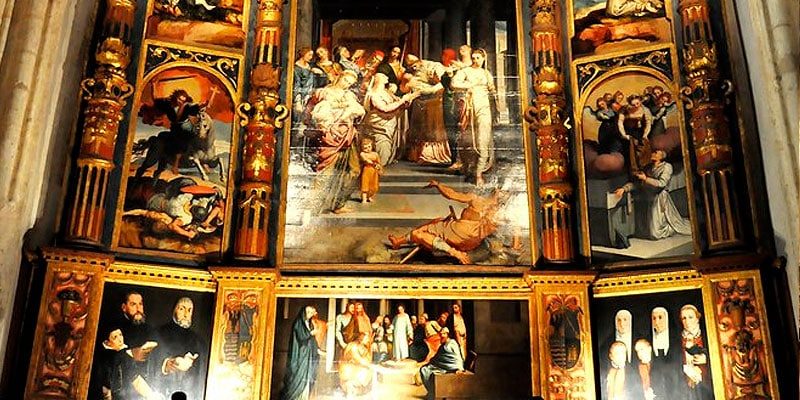


After the intervention of several architects under the design of Diego de Riaño, it was finished by Asensio de Maeda (mid-16th century). With an elliptical plan according to the meeting needs of the Cathedral Chapter, it was covered by a beautiful dome where the eight Sevillian saints and the Immaculate Conception stand out, all made by Murillo (17th century). Also noteworthy:
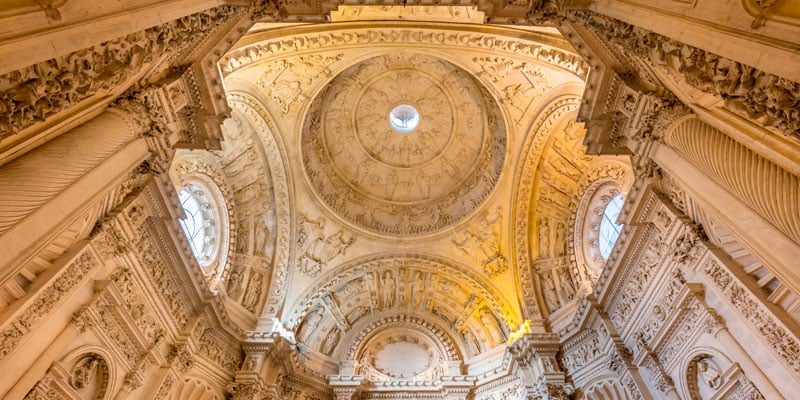
It is one of the most beautiful spaces of the Spanish Renaissance, finished by Martín de Gaínza under the design of Diego de Riaño (16th century). On the front of the Sacristy, The Descent, painting on panel by Pedro de Campaña (mid-16th century). Among the most relevant works are:
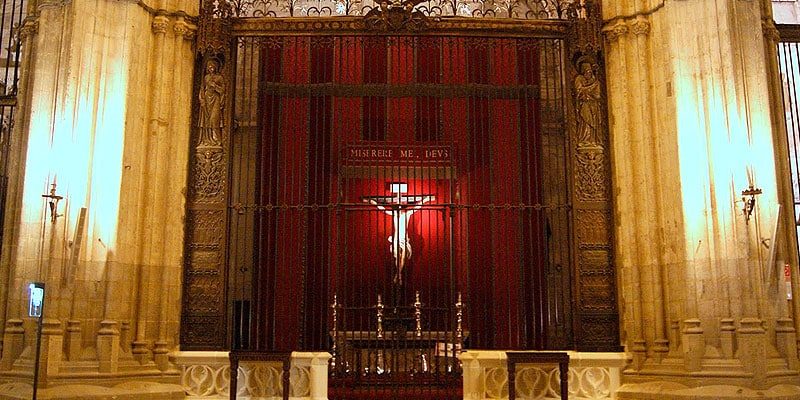
The martyrdom of Saint Andrew, a copy of the original painting (early 17th century) by Juan de Roelas gives its name to the chapel. The Gothic tombs from Toledo workshops from the beginning of the 15th century stand out, which accompany the marvelous carving of Christ of the Clemency made by Martínez Montañés (early XVII century).
Stained glass window: The Holy Supper by Arnao de Flanders (mid 16th century).
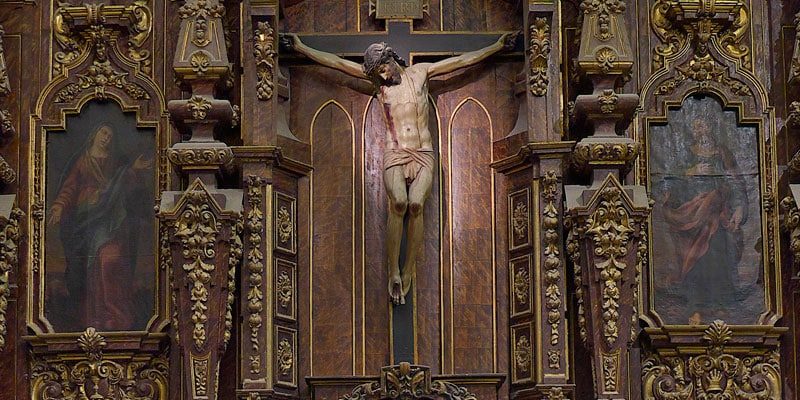
The tomb of Cardinal Marcelo Espínola (early 20th century) stands out, in the altarpiece a half-length image of the Virgin of Sorrows attributed to Pedro de Mena (17th century), a Crucified attributed to Juan Francisco Vázquez “the Old” (S. XVI) and the painting The betrothal of the Virgin and Saint Joseph made by Valdés Leal (mid 17th century). Through this chapel you can access the Sacristy of the Chalices.
Stained glass windows: Foot Washing of Arnao de Flandes (mid 16th century) and Cardenal Ilundain’s Coat of Arms (first half of the 20th century).
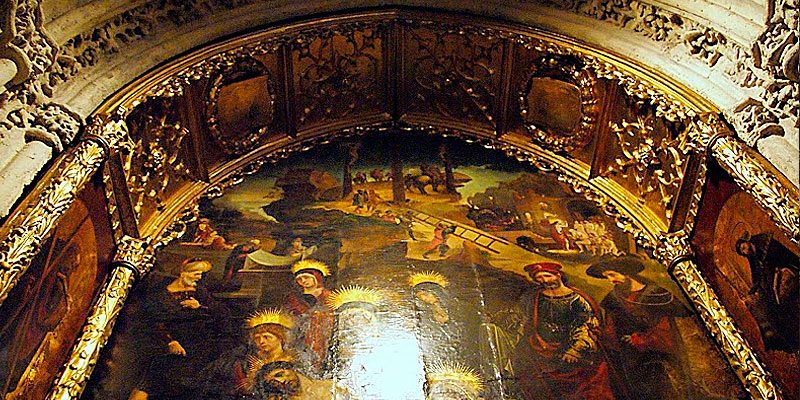
Located to the left of the San Cristóbal gate. The altarpiece is the work of Alejo Fernández, the representation of The Pietà, is attributed to the same painter (first quarter of the 16th century).
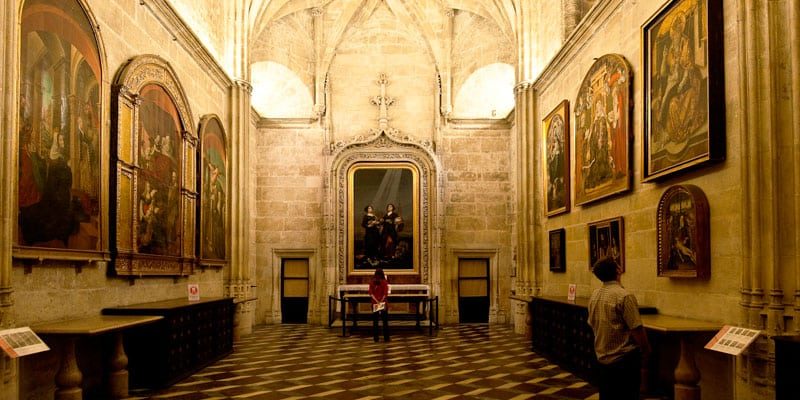
Several architects took part in its construction, which was completed by Martín de Gaínza (first half of the 16th century). Covered with a Gothic vault with ribs, it is a sampler of some of the best cathedral paintings.
Among the paintings stand out: The Adoration of the Kings by Alejo Fernández (early 16th century), The Calvary by Juan Núñez (late 15th century), The Virgin with the Child and Saint John the Baptist by Zurbarán (mid 17th century) , Lázaro with Saint Martha and Mary Magdalene by Valdés Leal (mid 17th century), The Glory by Juan de Roelas (early 17th century), The Circumcision by Jacob Jordaens (late 17th century) and The Saints Justa and Rufina by Francisco de Goya (early 19th century).

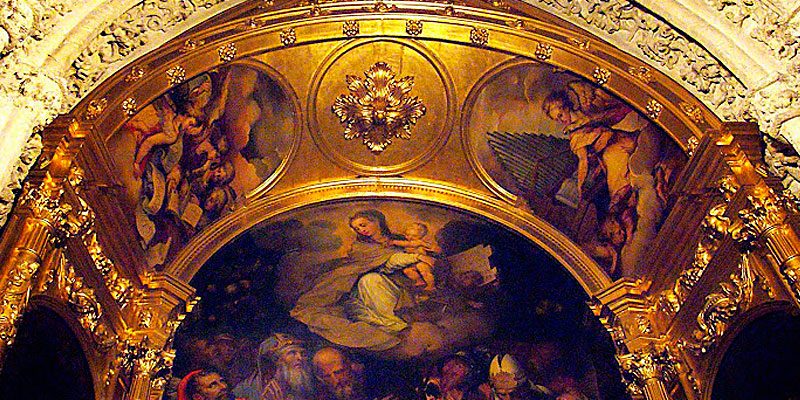
To the right of the San Cristóbal gate. Chapel finished by Pedro Delgado (mid 16th century), where the main panel stands out with an Allegory of the Immaculate Conception, also known as the Genealogy of Christ, painted by Luis de Vargas (half 16th century). The altar is also known as Altar of the Gamba (word that means leg in Italian) and which refers to the foreshortening of Adam’s leg in this work. Also note a clock by Fray José Cordero over the gate (late 18th century).
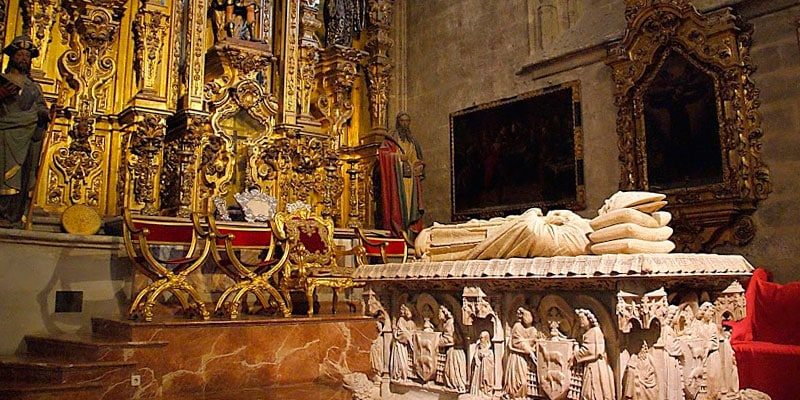
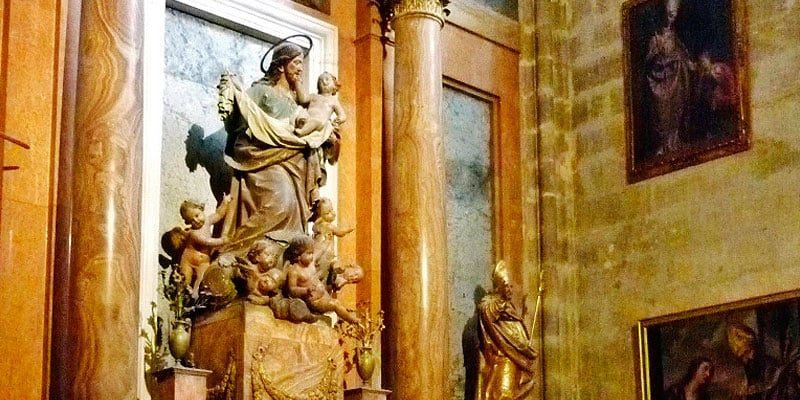
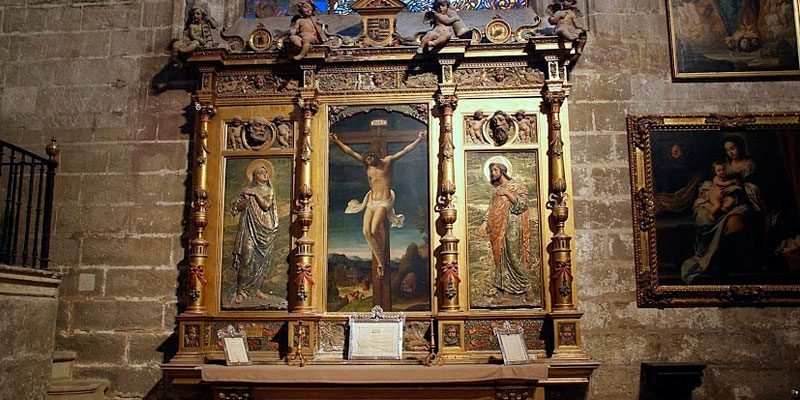
The anonymous altarpiece that has several polychrome panels with varied iconography in a magnificent example of Sevillian Gothic (early 15th century). Opposite another altarpiece, made by Joaquín Bilbao (early 20th century) from which hangs the Christ of Maracaibo, a magnificent painting attributed to Villegas Marmolejo (half 16th century). Note the tomb of Cardinal Luis de la Lastra y Cuesta made by Ricardo Bellver (end of the 19th century) and the anonymous Flemish-style painting of Abraham and the three angels (17th century).
Stained glass windows: Santa Águeda, Santa Lucía, Santa Cecilia and Santa Inés by Enrique Alemán (second half of the 15th century) and La Sagrada Familia, anonymous (end of the 18th century).
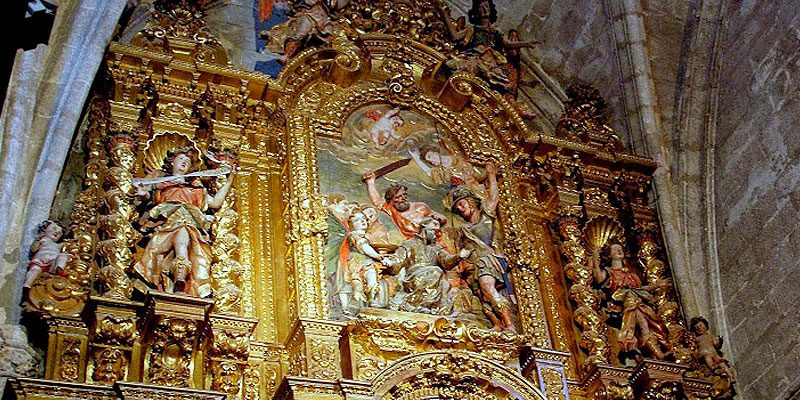
It was the first chapel to be completed in the new Cathedral. The solomonic altarpiece of anonymous carving (early 18th century), adapted to the vault, is presided over by the sculpture of Saint Laurean and iconographically traces the life of the saint. The paintings on the walls of Matías de Arteaga (early 18th century) also allude to his life. The tomb of Cardinal Joaquín Lluch belongs to Agapito Vallmitjana (late 19th century).
Stained glass windows: Saint Catherine, Saint Mary Magdalene, Saint Martha and Saint Margarita by Enrique Alemán (second half of the 15th century) and San Isidoro, San Laurean and San Leander by Vicente Menardo (end of the 16th century).
The chapels of the Cathedral of Seville house countless treasures, anecdotes and stories that our guides explain in an entertaining and effective way. We present here a small structure of the chapels, with some essential information, that visitors will be able to see in our tours of the chapels. From left to right, facing the west wall, they meet.
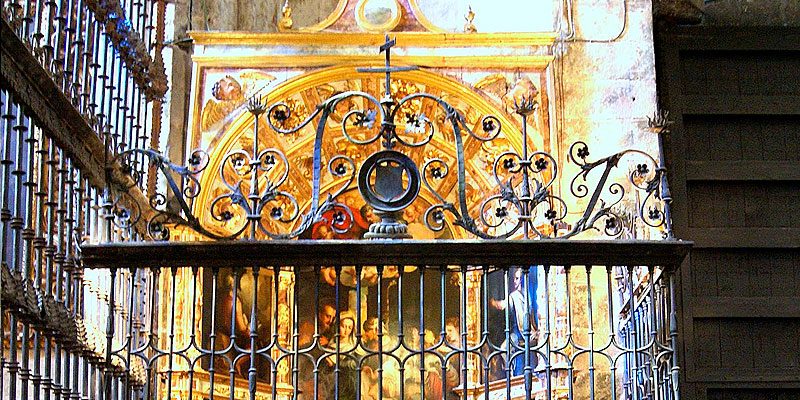
Altarpiece with paintings, made by Luis de Vargas (mid 16th century), where the Adoration of the shepherds is the main painting.
Stained glass window next to the altar: The Annunciation by Vicente Menardo (half 16th century).
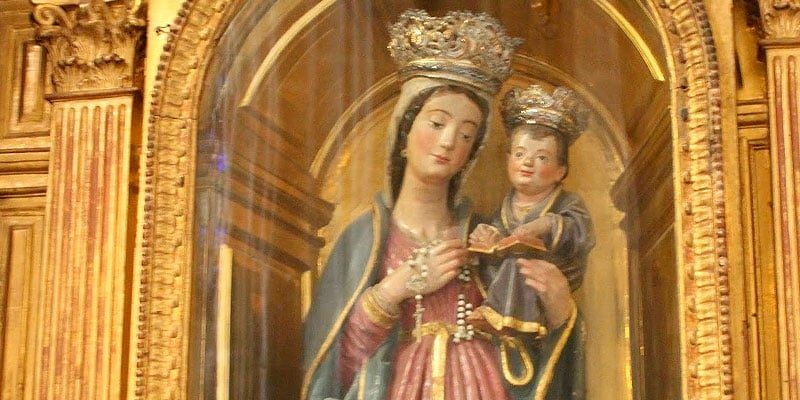
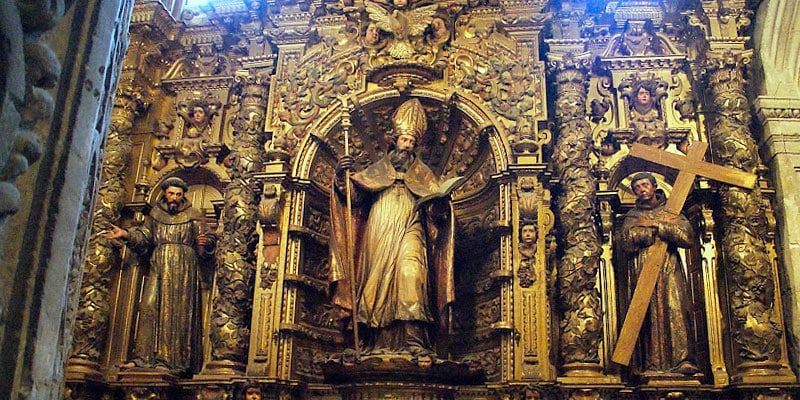

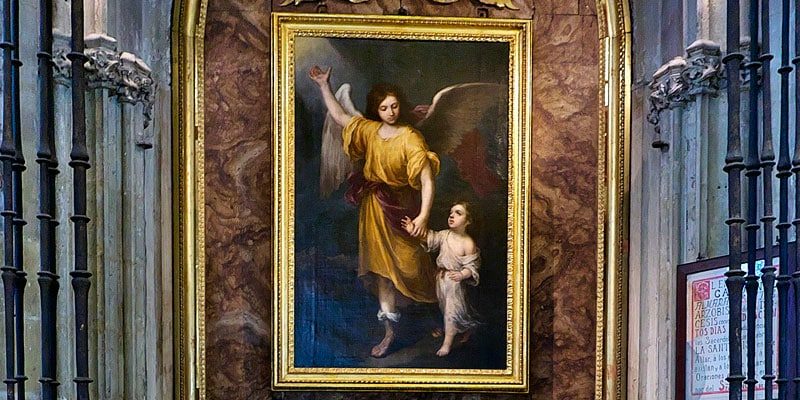

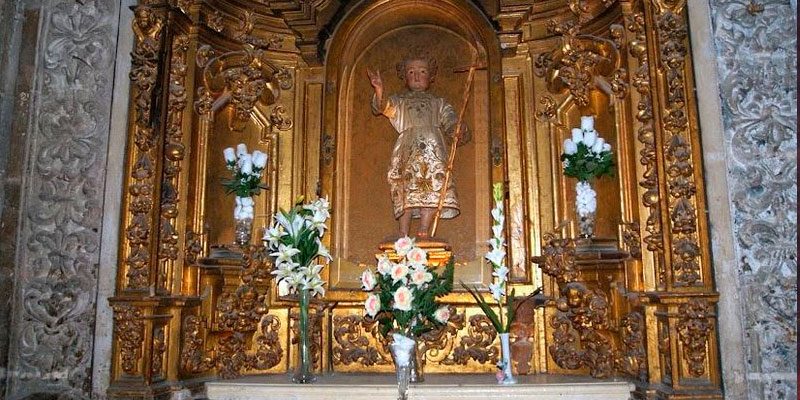
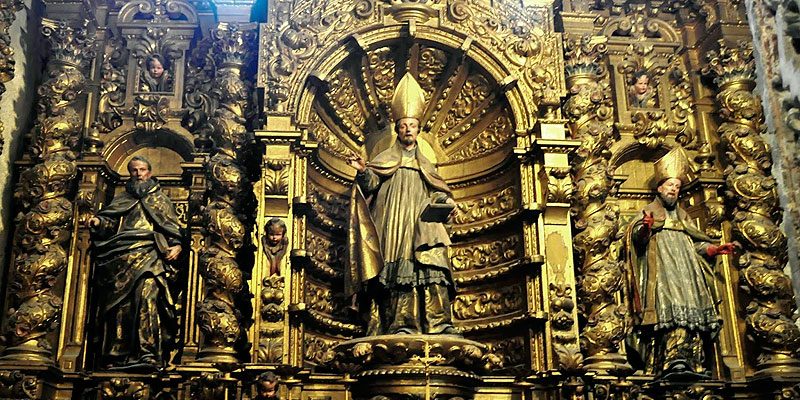
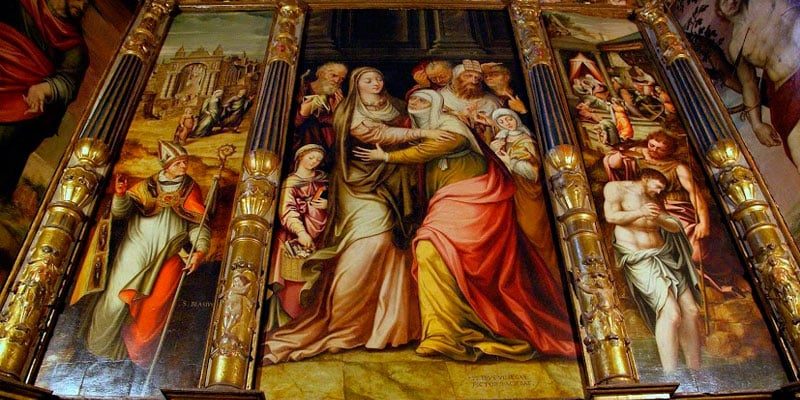
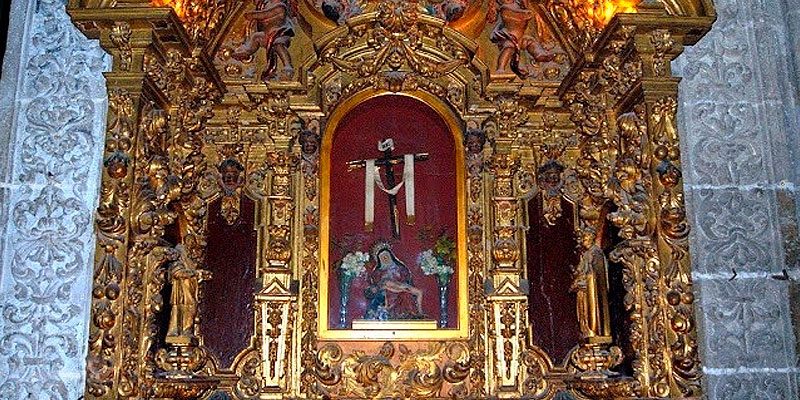

The chapels of the Cathedral of Seville house countless treasures, anecdotes and stories that our guides explain in an entertaining and effective way. We expose here a small structure of the chapels, with some essential data, that visitors will be able to see in our tours of the chapels. From left to right, facing the north wall.
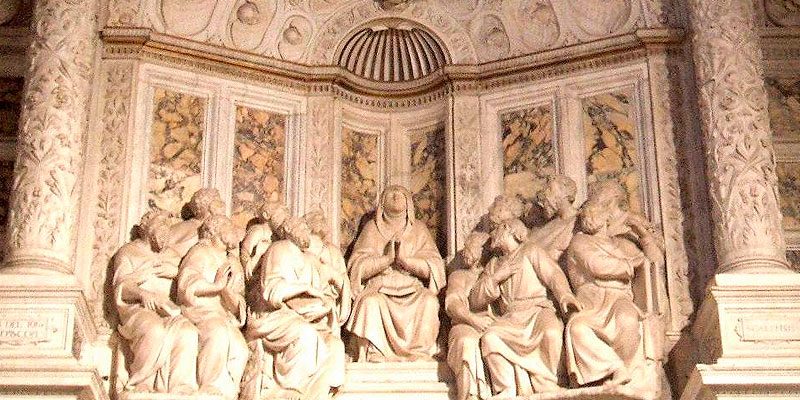

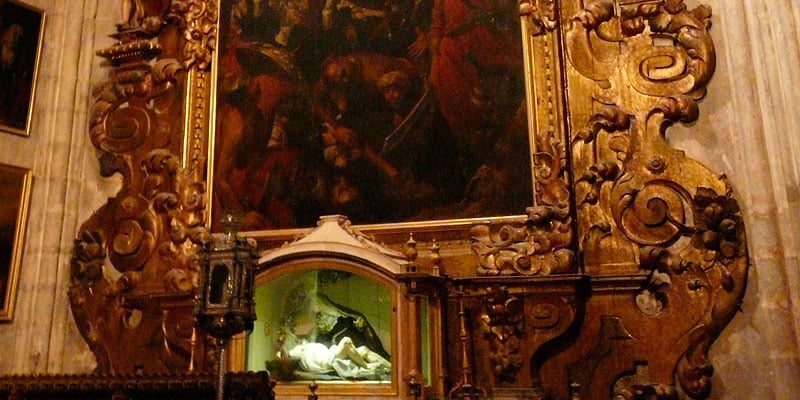
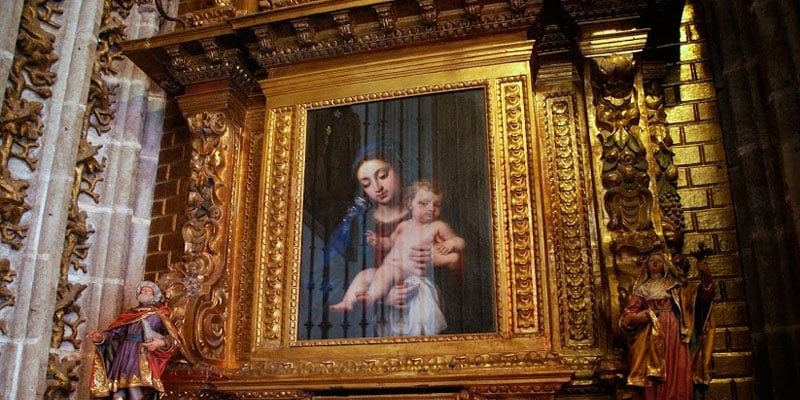



Founded at the beginning of the 16th century by Micer García de Gibraleón for his burial and as the headquarters of the brotherhood of poor marriageable maidens, so that they would have a dowry. Baroque altarpiece by José Rivera (18th century) that presides over the Annunciation and is accompanied by paintings from the 15th, 16th and 18th centuries. Stands out for its beauty, the Renaissance grille (third quarter 16th century).
Stained glass windows: St. Magdalene anointing the Lord’s feet by Arnao de Flandes (half 16th century) and, divided into two, The Virgin of Mercy and The Annunciation by Arnao de Vergara (first half 16th century).

The patron saint and archdeacon of Écija, Rodrigo de Santillán, commissioned Hernando de Esturmio to create the altarpiece with nine panels, including The Mass of Saint Gregory and The Resurrection (first half of the 16th century). The rest of the paintings are a varied saint list of Murillesque and Flemish influence.
Stained glass windows: The Resurrection of St Lazarus and The Birth of Christ, both made by Arnao de Flanders (half 16th century).
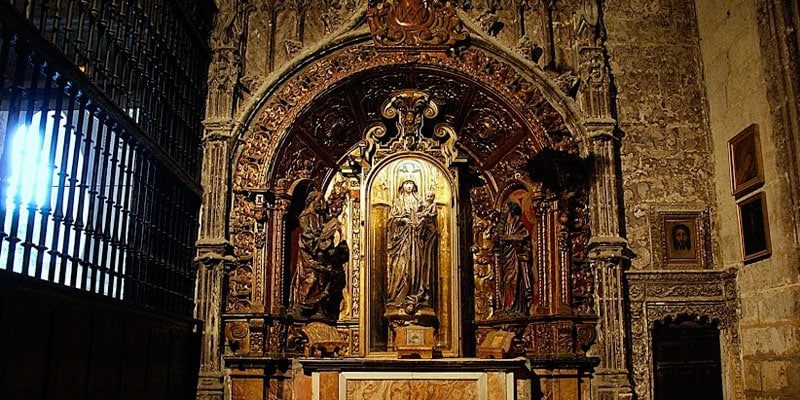
Located in the lobby of the Lizard Gate, it has belonged to the Pinelo family since the 16th century. The most remarkable thing is The Virgin of the Pillar by Pedro Millán made in fired clay (early XVI century) that presides over the baroque altar (late 17th century) and is flanked by the wooden carvings of Saint Peter and Saint Paul.
Stained glass window: Sacred Entry into Jerusalem topped by Allegory of Charity by Arnao de Flandes (half 16th century).
Visit its history, its doors, its altars and its works of art.
With our tour you will discover in detail one of the most beautiful places in the world.
With ten access doors and a rectangular floor plan, it is a model of the Cathedral that influenced many Novohispanic cathedrals after the conquest of the New World.
Our tours will show the wealth of paintings, sculptures, stained glass windows, forging, goldsmithing, clothing, books, etc., that make Seville Cathedral one of the great museums in Europe and a historical-artistic compendium of Catholicism.
Discover the history of the Cathedral of Seville through the centuries and the different historical periods through which it has passed, from the Almohad to the present.
Choose the days and indicate the attendees
Discover the Royal Alcazar of Seville



Go up and discover the sky of the city of Seville


